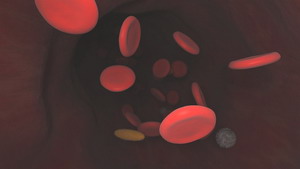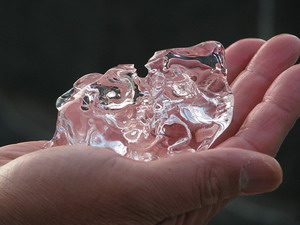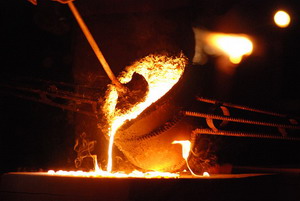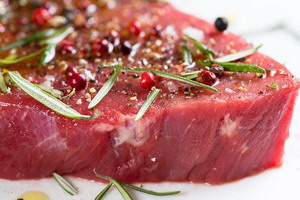 What is the most common nutrient deficiency in the US? As you might guess from the title of this article, the answer is iron. While half of Americans do not get enough magnesium, actual clinical deficiency is rare. Not so with iron. A big part of this deficiency issue is the move away from the consumption of red meat. Iron is what makes red meat red. Iron is the central element in hemoglobin, the oxygen-carrying component in our red blood cells. While there are vegetable sources of iron, the heme type iron found in meat is three times more absorbable than the forms of iron found in vegetables. Additionally, there are many anti-nutrients found in various plants that bind up and block the absorption of iron that are not found in animal sources of iron.
What is the most common nutrient deficiency in the US? As you might guess from the title of this article, the answer is iron. While half of Americans do not get enough magnesium, actual clinical deficiency is rare. Not so with iron. A big part of this deficiency issue is the move away from the consumption of red meat. Iron is what makes red meat red. Iron is the central element in hemoglobin, the oxygen-carrying component in our red blood cells. While there are vegetable sources of iron, the heme type iron found in meat is three times more absorbable than the forms of iron found in vegetables. Additionally, there are many anti-nutrients found in various plants that bind up and block the absorption of iron that are not found in animal sources of iron.
 I am sure most of you have heard of the dangers of iron poor blood. What we are really saying is that without enough red blood cells full of iron-rich hemoglobin, our body is not able to pick up oxygen from our lungs and carry that oxygen to all our body tissues to support the production of energy in all the cells of the body. This is called iron deficiency anemia. Under a microscope, this looks like your red blood cells have all shrunk down to half their normal size. But this is not the only purpose for iron in the body. Iron is necessary for the functioning of many enzymes, proper brain development, hormone synthesis, immune function, cellular health, cellular repair and replacement, memory, cognition, and much more.
I am sure most of you have heard of the dangers of iron poor blood. What we are really saying is that without enough red blood cells full of iron-rich hemoglobin, our body is not able to pick up oxygen from our lungs and carry that oxygen to all our body tissues to support the production of energy in all the cells of the body. This is called iron deficiency anemia. Under a microscope, this looks like your red blood cells have all shrunk down to half their normal size. But this is not the only purpose for iron in the body. Iron is necessary for the functioning of many enzymes, proper brain development, hormone synthesis, immune function, cellular health, cellular repair and replacement, memory, cognition, and much more.
 The biggest symptom of low iron levels is fatigue. Low iron levels are most common in women during their menstruating years due to the loss of blood. Any other reasons for blood loss, like a bleeding ulcer, colitis, wounds, intestinal parasites, too frequent blood donation, vampires, frequent aspirin or NSAID use, etc. will produce iron poor blood if the loss is chronic. Of special note is the use of proton pump inhibitors for stomach acid excess. These meds inhibit the absorption of all types of iron except those from meat sources. On the flip side, the other most common reason for low iron levels is simply not getting enough iron in your diet of the right sort. This is a serious concern for vegans and vegetarians as vegetable sources of iron are generally poorly absorbed. Fortunately, most cereal grain products are fortified with iron to help meet this need (think bread, breakfast cereal, etc ). Personally, I don’t see cereal products as healthy food sources, but most people eat them regularly in this country. Additionally, the soils our vegetables, legumes, and other food sources are grown in are frequently overly alkaline, over fertilized, or improperly watered resulting in the iron being unavailable for absorption by the plants.
The biggest symptom of low iron levels is fatigue. Low iron levels are most common in women during their menstruating years due to the loss of blood. Any other reasons for blood loss, like a bleeding ulcer, colitis, wounds, intestinal parasites, too frequent blood donation, vampires, frequent aspirin or NSAID use, etc. will produce iron poor blood if the loss is chronic. Of special note is the use of proton pump inhibitors for stomach acid excess. These meds inhibit the absorption of all types of iron except those from meat sources. On the flip side, the other most common reason for low iron levels is simply not getting enough iron in your diet of the right sort. This is a serious concern for vegans and vegetarians as vegetable sources of iron are generally poorly absorbed. Fortunately, most cereal grain products are fortified with iron to help meet this need (think bread, breakfast cereal, etc ). Personally, I don’t see cereal products as healthy food sources, but most people eat them regularly in this country. Additionally, the soils our vegetables, legumes, and other food sources are grown in are frequently overly alkaline, over fertilized, or improperly watered resulting in the iron being unavailable for absorption by the plants.
What other symptoms does low iron produce?
Pale skin/gums/nail beds
Shortness of breath
Heart palpitations
Restless legs
Mouth ulcers
Dry mouth
Dry damaged skin/hair
Poor memory
Dizziness
Cracks in mouth corners
Leg cramps
Headaches
Craving dirt or ice
Brittle nails/spoon shaped
Muscle weakness
Insomnia
Cold hands and feet
As you can see, iron affects many things. In my Health Assessment Questionnaire, the first thing I focus on is whether or not some form of anemia exists. In terms of body priority, this is number one. It is so intrinsic to the functioning of so many other systems in the body, that it must be working well before we can even address any other problems. Anemia can be a hidden cause for almost anything as poor oxygen levels in the blood undercut the metabolism of every cell type, keeping them from being able to function correctly. Blood flow is king.
 Iron is not all roses and happy ever afters. It has a dark side we must be aware of. Like most everything in the body, too much is as bad as too little. Excess iron in the body creates massive inflammation and premature aging. It is termed an acute phase reactant. This is particularly a problem for white folks that carry the gene for hemochromatosis (about 10%), though only about 0.44% carry the double gene that really kicks this up. Excess iron consumption from supplements is the main problem. We don’t often see overconsumption of liver as a cause of iron overload. In fact, accidental overdose from iron-containing supplements is the leading cause of fatal poisoning in children under the age of 6. Iron supplements will also interfere with thyroid medications and meds for Parkinson’s.
Iron is not all roses and happy ever afters. It has a dark side we must be aware of. Like most everything in the body, too much is as bad as too little. Excess iron in the body creates massive inflammation and premature aging. It is termed an acute phase reactant. This is particularly a problem for white folks that carry the gene for hemochromatosis (about 10%), though only about 0.44% carry the double gene that really kicks this up. Excess iron consumption from supplements is the main problem. We don’t often see overconsumption of liver as a cause of iron overload. In fact, accidental overdose from iron-containing supplements is the leading cause of fatal poisoning in children under the age of 6. Iron supplements will also interfere with thyroid medications and meds for Parkinson’s.
 If you need iron supplementation for low iron levels, you want to purchase iron in the ferrous form rather than the ferric form, as the ferrous is much better absorbed (but still not as good as the heme form found in liver and red meats.) The usual upper limit for iron supplementation is around 40 mg/day. This would be for the treatment of low iron levels. Daily intake for general health is about one-quarter of this amount. Pregnant women need extra to support the growth of the baby, about 27mg. Speaking of pregnancy, breast milk has a highly absorbable form of iron for the baby, but only enough to meet the needs of a baby up to 6 months of age. Beyond that, the baby needs additional iron from additional food sources.
If you need iron supplementation for low iron levels, you want to purchase iron in the ferrous form rather than the ferric form, as the ferrous is much better absorbed (but still not as good as the heme form found in liver and red meats.) The usual upper limit for iron supplementation is around 40 mg/day. This would be for the treatment of low iron levels. Daily intake for general health is about one-quarter of this amount. Pregnant women need extra to support the growth of the baby, about 27mg. Speaking of pregnancy, breast milk has a highly absorbable form of iron for the baby, but only enough to meet the needs of a baby up to 6 months of age. Beyond that, the baby needs additional iron from additional food sources.
 So how do you test to see if your iron levels are right? The simplest method is a blood test to check your ferritin levels. Ferritin is the storage form for iron in the body. Most of the iron in your body is in your blood, muscles, and bone marrow. There is only about a teaspoon of iron total in your body, 3-4 grams. Nevertheless, it is estimated that 80% of the population of the world may be deficient in iron. We are doing much better than the world’s average as we have much more food available to us. In spite of that, studies have found that women who take a regular supplement with iron are half as likely to complain of fatigue.
So how do you test to see if your iron levels are right? The simplest method is a blood test to check your ferritin levels. Ferritin is the storage form for iron in the body. Most of the iron in your body is in your blood, muscles, and bone marrow. There is only about a teaspoon of iron total in your body, 3-4 grams. Nevertheless, it is estimated that 80% of the population of the world may be deficient in iron. We are doing much better than the world’s average as we have much more food available to us. In spite of that, studies have found that women who take a regular supplement with iron are half as likely to complain of fatigue.
 One little myth about iron I want to bust is the image of Popeye the sailor man eating his spinach to build his strength. This was a marketing push based on the fact that spinach chemically has high levels of iron within it. However, because of the high levels of phytic acid and tannins in spinach binding up the iron and making it undigestable, less than 2% of the iron in spinach ever makes it into the body. Similar foods with high phytic acid are grains, peas, lentils, beans, soy, walnuts, and almonds. These anti-nutrients affect not only iron, but also zinc, magnesium, and calcium absorption. Oxalic acid is another plant anti-nutrient found in spinach and other dark greens, some berries, and some nuts. Too much of this in your diet and you end up with kidney stones and kidney disease. But you really have to eat a lot of greens to cause a problem – like 7 pounds in one day. So moderation in all things is a wise principle, just like variety is the spice of life. The gut loves variety in its foods – no overdoing it.
One little myth about iron I want to bust is the image of Popeye the sailor man eating his spinach to build his strength. This was a marketing push based on the fact that spinach chemically has high levels of iron within it. However, because of the high levels of phytic acid and tannins in spinach binding up the iron and making it undigestable, less than 2% of the iron in spinach ever makes it into the body. Similar foods with high phytic acid are grains, peas, lentils, beans, soy, walnuts, and almonds. These anti-nutrients affect not only iron, but also zinc, magnesium, and calcium absorption. Oxalic acid is another plant anti-nutrient found in spinach and other dark greens, some berries, and some nuts. Too much of this in your diet and you end up with kidney stones and kidney disease. But you really have to eat a lot of greens to cause a problem – like 7 pounds in one day. So moderation in all things is a wise principle, just like variety is the spice of life. The gut loves variety in its foods – no overdoing it.
 To wrap it up, iron is very important – in the right amounts. If you are chronically tired, iron is the first thing we check. If you are vegetarian then I would recommend you take a supplement with some iron in it after checking your blood to see if it is needed. If you are on stomach acid medication then you would need liver capsules to get in the heme type of iron as all the non-heme iron sources from plants require good stomach acid to be absorbed. If low iron is your issue, then all that tiredness may have an easy fix.
To wrap it up, iron is very important – in the right amounts. If you are chronically tired, iron is the first thing we check. If you are vegetarian then I would recommend you take a supplement with some iron in it after checking your blood to see if it is needed. If you are on stomach acid medication then you would need liver capsules to get in the heme type of iron as all the non-heme iron sources from plants require good stomach acid to be absorbed. If low iron is your issue, then all that tiredness may have an easy fix.
Take care,
David
